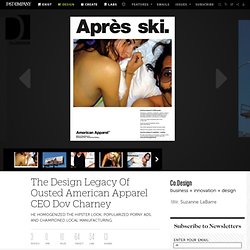

The Design Legacy Of Ousted American Apparel CEO Dov Charney. With its pop-sleaze aesthetic, American Apparel has helped shape (and ironically undercut) the standard tropes of fashion culture.

As chairman and CEO of American Apparel, Dov Charney embraced taboo subjects, traded in nostalgia, and pumped out designs using skin-tight spandex and plenty of sheer fabric. He played with perversity in the brand's clothes and advertising. He took the hipster look mainstream and homogenized it. Charney was canned this week from the company he founded in 1989. The decision grew out of an “ongoing investigation into alleged misconduct,” the brand said in a statement. And the ugly: Charney faced repeated sexual harassment lawsuits from employees, he showed up to a meeting naked but for a sock-as-fig-leaf, he walked around the factories in his underwear, and he staged provocative photo shoots in the basement of his mansion. Maybe not any more.
But it goes without saying that Charney had a unique vision. Everything good comes to an end, right? The Jeff Bezos School of Long-Term Thinking. If you want to know about Amazon CEO Jeff Bezos’ obsession with longevity, all you have to do is read up about his side projects.

You could check out his super-secretive aerospace company, Blue Origin. Or you could look in the Sierra Diablo Mountain Range in Texas, where Bezos is carving out a hole in one of the mountainsides to build a 10,000-year clock using $42 million of his own money. Why focus 10,000 years into the future? The answer lies in Bezos’ letter to Amazon shareholders from 1997 when the company went public, a manifesto of sorts about the benefits and approaches to long term thinking. The 1997 letter’s main point: we can’t realize our potential as people or as companies unless we plan for the long term. The company that started out as a few guys in a garage has now revolutionized the way we buy everything from books to toys to clothes.
We can’t realize our potential as people or as companies unless we plan for the long term. (Disclosure: Bezos is an investor in Behance.) 1. Meet Instagram CEO Kevin Systrom. Kevin Systrom, cofounder and CEO of Instagram, is one of Silicon Valley's newest hundred-millionaires, having sold his photo-sharing service to Facebook for $1 billion shortly before the social network went public. The early days Systrom grew up in a small town in Massachusetts and first dabbled in computer programming while in middle school. He eventually attended Stanford University, where he studied management science and engineering. Even though he didn't major in computer science, he coded on the side and made basic projects like a student marketplace and an Internet radio station. (Systrom also DJs as a hobby.) Systrom's first startup experience While at Stanford, Systrom got his first taste of the startup world when he interned at Odeo, which later turned into Twitter.
After he graduated from Stanford, Systrom took a job at Google as a marketing associate product manager. Systrom later left Google to join Nextstop, a startup founded by some former Googlers. Burbn The birth of Instagram. Ideo's CEO: 5 Reasons Global Firms Should Serve The Developing World. Beyond philanthropy, why should global companies invest in social impact projects in developing countries?

In a world of competing demands and economic challenges--even for the wealthiest companies-–why is this a good use of resources? Speaking in New York to an audience of world leaders, corporate titans, NGOs, and foundation heads at the opening session of the 2012 Clinton Global Initiative, Tim Brown, CEO of the design and innovation firm Ideo, said it was in multinationals’ self-interest to invest in things like health, education, and economic development in emerging nations. In setting the stage for the meeting, whose theme this year is “Designing for Impact,” Brown noted that “if we don’t deeply understand the communities that we serve, we can’t design for impact.
But by being embedded, we can get insights to ideas that may lead to products or services that that market may need.” 1. That idea, pioneered by C.K. 2. 3. 4. 5. "Design is all about learning from doing," Brown says. Aaron swartz. Remembering Steve. Sean Parker. Patrice.